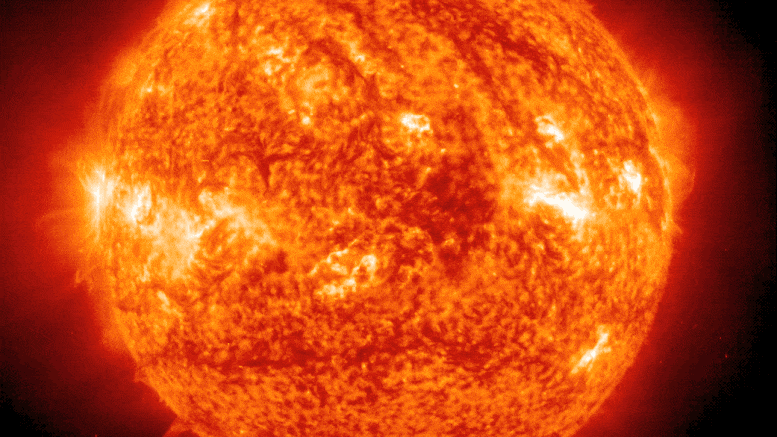A view of the sun from the Extreme Ultraviolet Imaging Telescope at the Solar and Heliospheric Observatory (SOHO) of ESA / NASA. SOHO was launched on December 2, 1995 and has spent a quarter of a century in space. Photo credit: ESA / NASA
The solar and heliosphere observatory was launched on December 2nd, 1995. A joint mission of the European Space Agency and NASA, SOHOThe original operating phase was planned for two years – and now it is celebrating a quarter of a century in orbit through repeated expansions. Over the years, the groundbreaking tools have become a source of a wealth of scientific knowledge, inspiration for follow-up missions, and a focal point for citizen scientists. SOHO also survived near the disaster twice and is the longest running spacecraft used to survey the sun. What this powerful mission has experienced in its 25 years has changed the way humanity sees the sun.
The revolution started in their design. SOHO should provide a comprehensive insight into the flow of energy and materials from the sun to the earth. The 12 instruments on board enabled the spaceship to return a special combination of observations – a benefit for solar scientists who wanted to understand how our star works. At the time, this type of basic physics research was considered the primary goal, but over the last quarter of a century researchers learned that they could actually start monitoring our sun in real time, studying space, and predicting the weather it sent us the way.
“At the time SOHO was designed, very few people were talking or thinking about space weather,” said ESA SOHO project scientist Bernhard Fleck. “But now I look at SOHO observations like weather radar. Now it’s as normal as opening up your weather app and checking when the rain is coming. ”
This ability is based on the corona diagrams of SOHO, special telescopes that block the sun’s bright face to allow better visibility of the faint light that extends from the star. SOHO’s Large Angle and Spectrometric Coronagraph, known as LASCO, offers a 360-degree view of the atmosphere around the sun.
December 2, 2020 will be the 25th anniversary of the Solar and Heliospheric Observatory (SOHO) – a joint mission of the European Space Agency and NASA. Since its start in 1995, the mission has kept an eye on the sun. This view of the sun was processed by scientists at the Naval Research Lab in Washington, DC, which manages SOHO’s LASCO instrument, to merge views from two of the LASCO coronagraphs: C2, which is shown closer to the solar surface, but a smaller one Field of view and C3, which has a wider field of view. The video begins in 1998 due to a change in the way data was stored after the first two years of the mission. Photo credit: ESA / NASA / SOHO / LASCO / NRL / Brendan Gallagher
New scientific discoveries arose from LASCO’s ability to map huge eruptions of solar material and magnetic fields, so-called coronal mass ejections or CMEs. Researchers were finally able to see the shape and structure of CMEs in breathtaking detail. When these storms are directed towards Earth, they can affect the functionality of spacecraft, threaten astronauts on spacewalks, and even, if very intense, hit power grids on the ground.
LASCO was particularly useful when looking at terrestrial storms known as Halo CMEs – so called because when you look at a CME coming towards us on Earth, it appears circular and surrounds the sun, much like inflating a balloon by looking at the top of the balloon. Before SOHO, the scientific community debated whether it was even possible to see a CME coming straight at us, but today LASCO images are the backbone of models for predicting space weather. They are regularly used to predict the impact of space weather events on Earth.
“A coronagraph observed around the sun helped us see CMEs coming our way,” said Terry Kucera, an astrophysicist in the solar physics lab at NASA’s Goddard Space Flight Center in Greenbelt, Maryland. “That was really important to understanding space weather and allowing scientists to study how CMEs affect us here on Earth.”
In addition to the daily monitoring of space weather, SOHO was also able to provide insights into our dynamic sun on longer time scales. The star changes magnetic polarity every 22 years. The activity increases and decreases every 11 years.
At the age of 25, SOHO observed full versions of both cycles. EIT, SOHO’s Extreme Ultraviolet Imaging Telescope capable of observing wavelengths of light that we cannot see from the ground as they are blocked by our atmosphere, was ready to see anything. The instrument revealed solar phenomena such as cross-solar waves in the corona associated with CMEs.
EIT was the first instrument of its kind to be in orbit and previously only flown on short rocket flights. The telescope’s continuous view of these processes made it an inspiration for other missions.
“I think SOHO has demonstrated the value of long baseline studies of phenomena changing on two-decadal time scales,” said former NASA project scientist Joe Gurman. “Perhaps as a result of this success SOHO produced successors.”
SOHO advocated higher resolution data and inspired suggestions for other missions. Spacecraft such as the Solar Dynamics Observatory and the Solar TErrestrial RElations Observatory owe their breathtaking observations in the extreme ultraviolet to their predecessor EIT. 25 years after launch, the technology for these newer missions has been significantly updated compared to SOHO.
“Back then it was a one-megapixel camera [of SOHO’s launch] was absolutely on the cutting edge of technology, ”said Fleck. “You couldn’t sell a cell phone with a 1 megapixel camera. If you compare the times, it’s all the more amazing that we’re still doing really competitive science with this old hardware. ”
Despite the fact that newer instruments have more advanced technology, SOHO remains an unmatched repository of continuous data. To date, six thousand scientific publications have used SOHO data, and the mission is still producing nearly 200 articles a year.
However, there was a chance that we might have lost that long period of data. The entire research potential of SOHO was almost lost in June 1998. During a routine spacecraft maneuver, the operations team lost contact with the spacecraft. With the help of a radio telescope in Arecibo, the team finally located the spaceship. SOHO went from being cold in space to being awake and productive in November of that year.
The spacecraft’s good health only lasted that long. Complications from the near-loss event emerged just weeks later when all three gyroscopes – which helped the spaceship point in the right direction – failed. The spaceship was no longer stabilized. Boldly, the team’s software engineers developed a new program that would stabilize the spaceship without the gyroscopes. It was another chance for the mission. SOHO resumed normal operations in February 1999 and was the first spacecraft of its kind to function without a gyroscope.
The story of SOHO’s recovery and legacy continues to motivate current US project scientist Jack Ireland to join NASA’s Goddard Space Flight in Greenbelt, Maryland.
“That’s one thing about SOHO that should be highlighted: it’s extremely ambitious. You have 12 instruments on a platform a million miles away and we’re going to look at the entire kit and the Sun’s Kaboodle? “Said Ireland. “And then to say, ‘We’re not going to give up. We’re going to fight for this thing. ‘That requires a level of ambition that inspires. ”
As Ireland looks to SOHO, he sees the mission’s productive past as evidence of a bright future
“Twenty-five years should only be the beginning. From a scientific point of view, we have to keep going, we can’t take our eyes off the sun. ”



